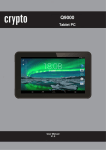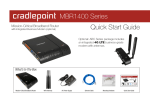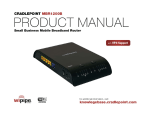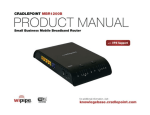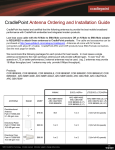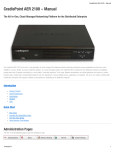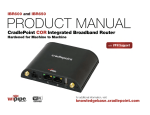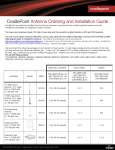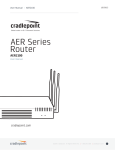Download Release Notes for CradlePoint rev 2
Transcript
Release Notes for CradlePoint Rev 5.3.4 Firmware
Products supported/tested:
2100
MBR1400 HW v2.0
MBR1400
MBR1200B
IBR1100
IBR1150
IBR600
IBR650
IBR350
CBA750B
Note1: Before upgrading to new firmware, it is always a good idea to save the configuration file
from your current version. This firmware version will remove a configuration for version 3.2 or
lower and will not try to keep your settings.
Note2: Revision 5.2.0 was a significant change from previous releases. Updating from
prior versions to 5.0.0 through the router UI or ECM will keep all current settings. Factory
resetting 5.1.0 and then re-applying a saved configuration from a pre-5.0.0 version may not
reset all saved passwords correctly. Downgrading from 5.2.0 or later to an earlier version
WILL force a factory reset on the router. Saving a 5.0.0 or later configuration and applying
it to an earlier version will change any non-default passwords to an unknown string.
Modems tested: (new 5.3.4 modems are in blue text)
USB Modems
CradlePoint MC200LE-VZ / Verizon (USA) / (GPS) Supported on MBR1400, CBA750B Only
CradlePoint MC200LE2-SP / Sprint (USA) / Supported on MBR1400, CBA750B Only
CradlePoint MC200LP / Bell, Rogers, Telus (Canada) / Supported on MBR1400, CBA750B
Only
CradlePoint MC200LP-AT / AT&T (USA) / Supported on MBR1400, CBA750B Only
CradlePoint MC200LP2-EU / EE (UK), Vodafone (UK, Germany), Tele2 (Sweden), Telia
(Sweden) / Supported on MBR1400, CBA750B Only
CradlePoint MC300LE-VZ / Verizon (USA) / Supported on 2100 Only
CradlePoint MC300LP / Bell Mobility, Rogers, Telus (Canada) / Supported on 2100 Only
CradlePoint MC300LP-AT / AT&T (USA) / Supported on 2100 Only
CradlePoint MC300LP2-EU / EE (UK), Vodafone (UK, Germany), Tele2 (Sweden), Telia
(Sweden) / Supported on 2100 Only
CradlePoint MC400LE2-SP / Sprint (USA)
CradlePoint MC400LPE-AT / AT&T (USA)
CradlePoint MC400LPE-GN / T-Mobile (USA); Bell Mobility, Rogers, Telus (Canada)
CradlePoint MC400LPE-SP / Sprint (USA)
CradlePoint MC400LPE-VZ / Verizon (USA)
CradlePoint MC400LP3-EU / EE (UK), Vodafone (UK, Germany), Tele2 (Sweden), Telia
(Sweden)
Franklin U600 / Sprint (USA) (3G Activation, PRL Update, FUMO, GPS)
Franklin U600 (“U600 3G/4G USB Stick”) / Virgin Mobile (USA)
Franklin U770 (“Sprint Plug-In-Connect Tri-Mode USB Modem”) / Sprint (USA)
Huawei E3276 / Telus (Canada)
Huawei E368 (“AT&T USBConnect Force 4G”) / AT&T (USA)
LG AD600 (“AT&T USBConnect Adrenaline”) / AT&T (USA)
LG Turbo LUU-2100TI (“USBConnect Turbo”) / AT&T (USA)
LG VL600 (“4G LTE”) / Verizon (USA)
Netgear AC340U (“AT&T Beam”) / AT&T (USA)
Netgear AC341U (“NETGEAR® 341U USB Modem”) / Sprint (USA)
*supports Netgear firmware 4.07.01.11 and MR2 firmware 45.04.20.00
Novatel 551L LTE (“Verizon USB551L”) / Verizon (USA)
Novatel U679 (“4G LTE Novatel Wireless U679 Turbo Stick”) / Bell Mobility (Canada)
Pantech UML290VW (“4G LTE”) / Verizon (USA)
Pantech UML295VW (“Verizon 4G LTE USB Modem UML2954G LTE”) / Verizon (USA)
*requires Pantech firmware version L0295VWD821F.B4 or later
Portsmith PSA1U1M ("Portsmith USB Client to Analog Modem Adapter") / POTS phone
providers
Sierra Wireless 250U / Sprint (USA) (3G Activation, PRL Update, FUMO, HFA)
Sierra Wireless 250U / Clear (USA)
Sierra Wireless 308 USB (“AT&T USBConnect Shockwave”) / AT&T (USA)
Sierra Wireless 313U (“AT&T USBConnect Momentum 4G”) / AT&T (USA)
Sierra Wireless 320U (“Telstra USB 4G (Sierra AirCard 320U)”) / Telstra (Australia)
Sierra Wireless 330U (“4G LTE Sierra Wireless U330 - Turbo Stick”) / Bell Mobility (Canada)
Sierra Wireless 330U (“LTE Rocket Stick – Sierra Wireless AirCard 330U”) / Rogers
(Canada)
Sierra Wireless 598U / Sprint (USA) (3G Activation, PRL Update, FUMO) (GPS)
Ubee U1901SP / Sprint (USA)
ZTE MF636 ("Rogers HSPA Rocket Stick") / Rogers (Canada)
ZTE MF683 (“T-Mobile Rocket 3.0 4G Laptop Stick”) / T-Mobile (USA)
ZTE MF691 (“T-Mobile webConnect Rocket 2.0”) / T-Mobile (USA)
ExpressCard Modems (MBR1400s, MBR1200B, CBA750B, CBR400, CBR450
only)
Novatel CC208 (“Merlin CC208 3G/4G 2-in-1 Card”) / Sprint (USA) (3G Activation, PRL
Update, FUMO)
Portsmith PS6EX1M ("Portsmith ExCard to Analog Modem Adapter”) / POTS phone
providers
USB Ethernet Adapters (2100, IBR1100, IBR1150, IBR600, IBR650, MBR1400s,
MBR1200B, CBA750B)
Plugable USB2-E1000 (“USB 2.0 to 10/100/1000 Gigabit Ethernet LAN”)
New features added in this release (Not all features are in all
products – see their respective Data Sheets):
Split DNS support under Network Settings -> DNS Configuration -> DNS Settings.
Content Filtering can now work with HTTPS as well as HTTP
(2100) Application ID’s can now be used to match QoS rules
Multiple Serial Port Redirector support. At the CLI, if a multi-port USB-to-Serial Port adapter
is connected to the product, the ports can be individually selected as “serial 1”, “serial 2”,
etc. Only one port is available at a time.
Ability to send a Break command to a device attached to a serial port. Using the “serial”
command at the CLI, a Ctrl-X will send a Break command to the attached device.
CLI access via device web UI under System Settings -> System Control -> Device Control.
This allows easy access to the router’s CLI, including the ‘serial’ command.
(IBR1100) WiFi-as-WAN WPA2 Enterprise for 2.4GHz radio. This allows connection to a
Access Point using WPA2 Enterprise authentication.
LLDP. Added Model Name and Firmware Revision to the LLDP string.
SSH. We limited the server cipher list to this subset: aes128-ctr,aes192-ctr,aes256-ctr
Security defects fixed:
HTTP Proxy support was added in the 5.3.0 Release as part of Content Filtering. This
added a firewall rule that allowed traffic to go to the Proxy when Content Filtering was
enabled. This rule was too open and allows use of the Proxy.
HTTP Proxy was patched to mitigate CVE-2015-1031. There are no known exploits for that
vulnerability.
Default GRE firewall rules allowed configured tunnel route destinations to be reached by a
carefully-crafted packet injected from other interfaces on-link with the WAN. This does not
affect typical Internet WAN connections such as modem, DSL, or cable modem. This can
only be exploited across an Ethernet WAN.
Additional UI/Usability changes:
LPE, E products. Rather than displaying the modem firmware version, the modem package
version now displays for more accurate update notification.
Defects fixed:
Management Address field in LLDP did not match the Admin Access address for the
interface.
LLDP Wireless LAN always reported as off
5.3.0 GPS migration missed the “always_poll” flag
Zscaler Internet Security improved the failover and failback abilities
“*” was not allowed in Webfilter Rules
LPE, LE products. If the APN was manually entered via the router’s GUI, modems would
connect on LTE but some would not connect on eHRPD (3G). Patched issue to allow
eHRPD connections.
LPE products. Repaired mismatched carrier SIM issue when modem is switched from one
carrier firmware load to another
Known issues:
IPSec. Certificates do not work if Router Services used (new feature in 5.2.0)
IPSec. IKE Phase 2 SHA2-256 Hash is incompatible with the latest Cisco and Juniper
firmware releases. CradlePoint routers are still compatible with each other.
If any of the router’s WAN connections (Ethernet, Wi-Fi as WAN, modem) connects to a
device that has the same IP subnet as the router, the router will disable the interface and
provide a Bounce Page warning that the WAN interface has a conflict. Simply change the
LAN IP Address on the Network Settings -> WiFi / Local Network Settings page in the UI.
Wi-Fi as WAN
The router will not connect to a host router that is in WPA-Enterprise mode.
You cannot connect to another router using WPS. The WPS setting in the router works for
a client attached to it, not for it to attach to a host router.
Wi-Fi
If WEP or TKIP encryption is used, the router will not broadcast above 54Mbps. This is a
WiFi Alliance logo certification requirement for new devices. WEP and TKIP have both
been deprecated by the WiFi Alliance and WPA2/AES is the default router encryption.
Carrier
AT&T. These modems appear to block some incoming ports. That affects the ability to use
features such as Remote Management.
LTE
Unless you have a specific service from your carrier, LTE modems will not generally provide
an externally-available IP address. Services, such as Remote Management, will not work.
Modem
Franklin U301. The modem works well in the router as the primary WAN interface. But if it
is used in failover mode with an Ethernet connection, the modem may not be able to
connect when the Ethernet connection is removed.
Franklin S600C. This modem’s firmware version or signal strength information may not be
correct.
Franklin U770. The Modem’s Ethernet address conflicts with the default address of the
Guest LAN. A warning message is placed in the log and the Guest LAN is disabled. If you
change the address of the Guest LAN to a non-conflicting address, this restriction will not
occur.
Sierra Wireless 313U, 330U, 340U, 598U. When these modems connect on 2G or 3G
bands, specifically on GSM 850, they will sometimes cause interference on the USB bus,
resulting in the modem not plugging properly. If this occurs, attaching the modem to a USB
extension cable will generally fix the problem.
The following USB modems contain an embedded web server through which many modem
settings are configured. To access the modem’s web pages, you must be logged in as the
router administrator. Once logged in, you can then access the modem web pages at these
given IP addresses:
Franklin U770 / Sprint (USA)
-> 192.168.10.1
Netgear AC341U * / Sprint (USA)
-> 192.168.1.1
(address is configurable)
Pantech UML295VW * Verizon (USA) -> 192.168.32.2
* The modem web pages are available only when the modem is operating in NAT mode.
WiMAX
Please be sure that the realm configured in the router matches your WiMAX provider's
recommendations.
Release Notes for CradlePoint Rev 5.3.3 Firmware
New features added in this release:
WiFi changes for European EN300328 requirements. Only affects European SKUs of
products listed.
Additional UI/Usability changes:
None
Defects fixed:
None
Release Notes for CradlePoint Rev 5.3.2 Firmware
Defects fixed:
None
Release Notes for CradlePoint Rev 5.3.0 Firmware
New features added in this release (Not all features are in all
products – see their respective Data Sheets):
VLAN Redesign under Network Settings / WiFi / Local Networks / VLAN Interfaces. This
includes VLAN support for WAN interfaces.
HTTP Proxy support was added under Network Settings / Content Filter / Upstream Proxy
Settings. Proxying HTTPS traffic will not work transparently.
ZScaler Internet Security added to the Network Settings / Content Filter / Cloud Based
Filtering/Security page.
LLDP support is added under System Settings / Administration / LLDP. It can be enabled
for WAN or LAN, and devices that are discovered are shown under the Status / LLDP page.
Additional options are added to the System Settings / System Control / Ping Test to be able
to set the Packet Size and Don’t Fragment.
(CLI only) Additional options are added to traceroute, including MTU discovery and a
number of other features.
Allow SNMP traffic on the WAN interface when IP Passthrough mode is enabled.
(IBR1100) Additional TAIP support added, including multiple clients and servers (up to 4).
Distance-based reporting was added.
(IBR1100) Enabled OpenVPN and VLAN support.
(2100) WiFi changes add Airtime Fairness. Airtime fairness support for the 2100 has been
added. Airtime fairness distributes available wireless airtime more fairly between clients of
different speeds, resulting in better performance for more capable client devices. Airtime
fairness is disabled by default. It can be enabled under the Advanced WiFi Settings page
for each radio.
(2100) Firewall integration with IPS. Network Settings / Firewall Configuration / Application
Sets allows filtering support by type of Application configurable by Zone.
(2100) Redesigned UI for Threat Management. Improved visibility and configuration of the
'Threat Management' categories and signatures. Added the ability to separately configure
whole categories of signatures, as well as individual signatures. Added the ability to search
(or filter) on the signature ID or text found in the signature description, like a CVE number.
(IBR6x0LPE, IBR11x00LPE, MC400LPE) Modem Multi-Carrier Software Switching. Allows
for switching of modem firmware from one North American cellular carrier to another North
American cellular carrier.
(IBR6x0LP2, IBR6x0LP3, IBR6x0LP, IBR6x0LPE, IBR11x0LP3, IBR11x0LPE, MC400LP3)
Smart Operator Selection. Extension of this IBR6x0P feature to more models. When this
feature is enabled and when used with a globally-provisioned SIM, the router scans for
available mobile broadband networks then selects the best network based on userconfigurable values.
Additional UI/Usability changes:
MAC Address filtering by range, allowing a range of MAC Addresses to connect to the router
instead of entering multiple host MAC Addresses.
SNMP Password requirements when the router is in Advanced Security Mode are the same
as for the Administration Password.
Removed ZScaler from the Enhanced Enterprise License.
(IBR6x0LE2, IBR6x0LPE, IBR11x0LPE, MC400LE2, MC400LPE) Modified underlying
attempts and retries for more successful Sprint LTE activation results.
UPnP is disabled by default. The setting still exists, but is not enabled.
Defects fixed:
Ethernet port auto-negotiation. Link speed configuration has changed to set the Ethernet
port link speed to the specified value instead of auto-negotiation plus advertisement of a
single link speed. If an existing configuration relied on auto-negotiation plus advertisement
of a single link speed, the link might not come up depending on the connected third-party
hardware.
In Release 5.2.3 we fixed a possible Man In the Middle attack while using ECM. The ECM
client was not validating the certificate handed to it by the ECM server.
Known issues:
IPSec. Certificates do not work if Router Services used (new feature in 5.2.0)
IPSec. IKE Phase 2 SHA2-256 Hash is incompatible with the latest Cisco and Juniper
firmware releases. CradlePoint routers are still compatible with each other.
(IBR600/IBR650/CBA750B) Modem update. If you update the internal modem or modem
cap using the UI to upload the modem file, you may run out of resources. Please use the
Over-the-Air or ECM update to update your modem. This limitation will be removed in a
future release.
Release Notes for CradlePoint Rev 5.2.3 Firmware
New features added in this release (Not all features are in all
products – see their respective Data Sheets):
Route Manager. Multiple changes were made to networking support to better support
default routes with networking protocols.
Improved DHCP relay support across a VPN tunnel.
Added the ability to support Multicast for GRE tunnels.
Additional UI/Usability changes:
Routing
Defects fixed:
Updated OpenSSL to version 1.0.1i. There was no known exposure from the previous
version.
Release Notes for CradlePoint Rev 5.2.2 Firmware
New features added in this release (Not all features are in all
products – see their respective Data Sheets):
CradlePoint Secure Connect (CPSC) Port Forwarding. A CPSC tunnel can now be added to
a zone for Port Forwarding traffic from the tunnel. The Zone NAT rules can be created for
any source zone to specify destination Port Forwarding similar to the existing WAN Port
Forwarding Rules. However unlike existing WAN Port Forwarding Rules, Zone NAT rules
apply to all traffic from the source zone to any destination IP not just to traffic for the WAN IP
destination.
(IBR6x0P only) Smart Operator Selection. When this feature is enabled and when used with
a globally-provisioned SIM, the router scans for available mobile broadband networks then
selects the best network based on user-configurable values.
Additional UI/Usability changes:
Network Settings, Content Filter. The Rule Priority column can now be used for sorting.
System Settings -> Administration -> Local Management -> System Identifier. The filter
on this was too strict and wouldn’t allow certain ASCII characters. It has been changed
to allow for all ASCII characters.
Internet -> VPN Tunnels Pre-Shared Key. A filter was added to restrict the PSK to a toostrict subset of ASCII characters. This filter was changed to allow printable ASCII
characters.
Network Settings -> Wi-Fi -> Local Networks. Changing Channel Selection method and
refreshing the screen would cause Wi-Fi settings to show as blank.
Internet-> Connection Manager-> Edit-> General Settings. Added configurable retry
settings to IPv4 Failure Check. Default values are those recommended by CradlePoint
for best Internet connectivity.
Defects fixed:
Zone Firewall GRE filtering was fixed
IPS Add/Removal of Signatures to the whitelist might fail was fixed
(IBR600/IBR650) GPIO Output not switching value with Modem Connected was fixed
Wired WAN (Ethernet), Active DNS doesn’t failover was fixed
(MC400xxx only) When the modem encounters a link down connection, the modem now
correctly reports it is not connected.
Known issues:
IPSec. Certificates do not work if Router Services used (new feature in 5.2.0)
If any of the router’s WAN connections (Ethernet, Wi-Fi as WAN, modem) connects to a
device that has the same IP subnet as the router, the router will disable the interface and
provide a Bounce Page warning that the WAN interface has a conflict. Simply change
the LAN IP Address on the Network Settings -> WiFi / Local Network Settings page in
the UI.
(IBR600/IBR650/CBA750B) Modem update. If you update the internal modem or
modem cap using the UI to upload the modem file, you may run out of resources.
Please use the Over-the-Air or ECM update to update your modem. This limitation will
be removed in a future release.
Release Notes for CradlePoint Rev 5.2.0 Firmware:
New features added in this release (2100, MBR1400, IBR6x0,
MBR1200B, CBA750B only. Not all features are in all products – see
their respective Data Sheets):
(2100) Threat Management. Network Settings -> Threat Management is a licensable
feature and provides Intrusion Prevention/Intrusion Detection.
Zone Firewall. Network Settings -> Firewall Configuration has been significantly changed
from previous firmware versions. The most important change is the Zone Firewall
implementation.
Router services and VPN. NTP, DNS, and Enterprise Cloud Manager will all now be
pushed through a VPN tunnel if ‘Router Services’ is enabled and a remote network of
0.0.0.0/0 is configured in the VPN Tunnels -> Add Tunnel -> Remote Networks page.
(IBR6x0) Increase the maximum number of GRE tunnels from 5 to 10.
Modem Settings: APN management enhancement, added Default Override (allows for APN
entry on the modem’s default profile slot). Removed Manual option. Affects all GSM and all
LTE modems, including CradlePoint and carrier-released USB modems.
Modem Settings: Auto APN (attempt connection on assumed home carrier’s APN if default
modem APN fails to connect). Added to CradlePoint GSM modem-based devices only:
IBR6x0P, ARC/COR LP, ARC/COR LP2, ARC/COR LP3, ARC/COR LPE-AT, ARC/COR
LPE-GN products
Additional UI/Usability changes:
Modem Settings: Home Only (lock to home carrier). Added to CradlePoint GSM modembased devices only: IBR6x0P, ARC/COR LP, ARC/COR LP2, ARC/COR LP3 products
Defects fixed:
Many OpenVPN defects have been fixed
Updated OpenSSL to version 1.0.1h
Known issues:
IPSec. Certificates do not work if Router Services used (new feature in 5.2.0)
Release Notes for CradlePoint Rev 5.1.2 Firmware:
New features added in this release (2100, MBR1400, IBR6x0,
MBR1200B, CBA750B only. Not all features are in all products – see
their respective Data Sheets):
Config difference CLI command: ‘diff’ from the command line will show any configuration
items that are different than the default.
ARP CLI command: ‘arpdump’ from the command line will dump the ARP table.
(IBR6x0) Prepend System ID to GPS Sentences. System Settings -> Administration -> GPS
-> Include System ID.
(IBR6x0) Increase the maximum number of GRE tunnels from 5 to 10.
Network Mobility (NEMO) changes to support failover. NEMO can be configured to operate
with a specific WAN and will activate when a disconnection is detected from a primary WAN
connection, or BGP or VRRP detect a peer failure.
Additional UI/Usability changes:
Added a Red/Green indicator to the banner showing if the router is connected to ECM.
For CradlePoint-based modems with supporting GPS, added ability to select between AUX
and GPS ports to obtain coordinates.
Defects fixed:
NHRP with dual WAN connections does not come back up after a WAN failover
SSH ‘cat’ command occasionally skips config portions
Special Characters in System Identifier field can cause UDHCP to fail
IBR600P/IBR650P only. Enabled SMS access for these devices
Added data throttling to resolve a USB overrun situation that resulted in the router rebooting
itself
Release Notes for CradlePoint Rev 5.1.1 Firmware:
New features added in this release (2100, MBR1400, IBR6x0,
MBR1200B, CBA750B only. Not all features are in all products – see
their respective Data Sheets):
No new features, defect fixes only.
Additional UI/Usability changes:
No new features, defect fixes only
Defects fixed:
Update to OpenSSL version 1.0.1g to mitigate CVE-2014-0160, aka the “Heartbleed” Bug
Release Notes for CradlePoint Rev 5.1.0 Firmware:
New features added in this release (2100, MBR1400, IBR6x0,
MBR1200B, CBA750B only. Not all features are in all products – see
their respective Data Sheets):
System Settings -> Certificate Management. Certificate Management is a centralized
system utility to import, export, create, and remove digital certificates. Local services can
access stored certificates for authentication, verification, or for other security functions.
Certificates can either be imported or exported via the PEM format, or bundled with a CA
certificate for import or export via the PKCS12 format. Current services utilizing Certificate
Management are CP Secure Connect, IPSec VPN, and WPA Enterprise Wifi as WAN.
o Certificates from Release 5.0 or earlier will not migrate automatically to the new
Certificate Manager, and Certificates created and managed in Release 5.1 or beyond
will not work if the router is downgraded to an earlier Release. A factory reset is
required if Certificates are used in 5.1 or later and the router is downgraded to 5.0 or
before.
Add ability for negation on source and destination addresses in WAN Affinity was added.
Internet / CP Secure Connect. CradlePoint’s cloud VPN solution has been renamed to ‘CP
Secure Connect’ and has been removed from Beta status. CP Secure Connect also
supports full tunnel VPN. Full tunnel support can be created by selecting the local LAN (Ex.
192.168.0.0/24) with a remote network configured as 0.0.0.0/0.
o CP Secure Connect will only create a single tunnel unlike IPSec that can create
multiple tunnels.
o CP Secure Connect has been removed from the Extended Enterprise License (EEL).
It now has its own license.
Added additional Modem diagnostics to SNMP. These include CINR, SINR, RSRP, RSRQ,
and a number of other values. The latest WIPIPE MIB version is 1.8 to reflect these
changes.
Added client site visit reporting to the log that reports which clients accessed an external IP
address. Network Settings -> Firewall Configuration -> Firewall Options -> Log Web
Access.
Active and passive DNS Failure Check added to Ethernet WAN sources to make their
Failure Check options match what is provided for modems.
(2100 only) Band-steering has been added. If a client is attached to the 2.4GHz radio on
the 2100 and it is capable of using the 5.0GHz radio, it will be steered to the generally more
open and higher-performing band. Band-steering is enabled whenever the SSID of the
2.4GHz and 5GHz radios are the same. Note that band steering may negatively impact
connectivity in some situations, especially at long range. If you see performance or
connectivity issues it is recommended that you disable band-steering by setting the 2.4GHz
SSID and 5 GHz SSID to different values.
RADIUS timeout and retry settings have been added for Hotspot support.
Added the ability to prioritize VOIP packets from the LAN to the WAN when using a VPN
tunnel. Any QoS DSCP codes will be copied from the inner packet to the VPN packet after
VPN encryption.
Additional UI/Usability changes:
NOTE: Local SSH has been enabled by default. This means that local clients can
SSH to the router using the admin username and password or other usernames if
Advanced Security Mode is enabled. WAN/Remote SSH has not been changed.
Modem diagnostics. Extended, categorized and sorted modem diagnostic information on the
page.
Modem Settings, On Demand Start Connection checkbox. When checked, the modem will
connect to begin On Demand mode after plug or reset. When unchecked, the modem will
not connect to begin On Demand mode after plug or reset, but will wait for LAN to WAN
traffic before initiating a connection.
SMS interface extension. Added Help command.
The wireless band has been added to the Wi-Fi clients list.
An Asset Tag field has been added to the router under the Local Administration tab.
Added ability for negation on source and destination addresses in WAN affinity.
Defects fixed:
IE9 and IE10 UI issues when setting up VPN tunnel
CP Secure Connect tunnel did not re-establish after reboot
GRE failover was not working correctly in some conditions
Clients dropped off of the Clients List and returned
OpenDNS might have issues reconnecting after reboot, depending on the speed of the
WAN reconnection
SSH to Serial port was scrambling data
Release Notes for CradlePoint Rev 5.0.1 Firmware:
New features added in this release (MBR1400, IBR6x0, MBR1200B,
CBA750B only. Not all features are in all products – see their
respective Data Sheets):
Added login alert
Added reboot counter in CLI under /config/system/admin/reboot_count.
Additional UI/Usability changes:
Updated the Dashboard to show when the router is being managed by ECM.
OpenDNS / Zscaler help – Open hotlink in a new tab
Defects fixed:
Status/Client List: Client pulls v4/v6 address semi-randomly
CP Connect: Bad CA File Name Exception
CP Connect: Client doesn’t seem to hold on to its X.509 certificate
Help System needs updated content for new modem failure check ping
Data Usage Rules not working when using two of the same modems
RIP Feature wasn’t grandfathered properly from 4.4.x
Added L2TP support to IBR600/650
Release Notes for CradlePoint Rev 5.0.0 Firmware:
New features added in this release (MBR1400, IBR6x0, MBR1200B, CBA750B
only. Not all features are in all products – see their respective Data Sheets):
Added support for new modems (see Modem list above).
VPN Improvements – Internet / OpenVPN. OpenVPN has been added to provide SSL VPN
support.
L2TP support for a WAN interface is provided under Internet / L2TP Tunnels.
GRE: Failover/Failback and WAN Binding support has been added.
VPN Failback. This feature allows two or more VPN tunnels to be created that will failover if
one connection goes down and will fail back if the higher priority connection is available. It
is configured in the VPN Tunnels wizard / Dead Peer Detection page.
Filter packets going through the modem that do not match the network. This feature is
enabled by default and can be disabled using Internet / Connection Mannager / Common
Defaults / Modem Settings.
Internet / CP Connect (Beta feature in 5.0). CP Connect tunnels can be used to create a
connection to a private network.
Internet / WiFi as WAN. (MBR1400v2 only). WPA2 Enterprise Authentication added to WiFi as WAN option.
Zscaler cloud-based filtering/security added under Network Settings / Content Filter / Cloud
Based Filtering/Security.
SMS access. Now enabled for all products on this platform.
Extended Enterprise License (MBR1400v2, IBR6x0 only):
System Settings / Feature Licenses. An Extended Enterprise License will enable a number
of features on those routers. For more information visit the Feature and Application License
page on the CradlePoint web site.
Routers upgrading from earlier firmware versions will automatically be granted a license to
the existing features that will fall under the EEL (STP, VRRP, etc.).
Additional UI/Usability changes:
First Time Setup Wizard / Configuring Failure Check. Enabling Failure Check here will
default Ethernet and WiFi as WAN checks to use a ping, and modems to Passive DNS.
Added IP WAN Subnet Filter checkbox to Modem Settings.
Added Enable AUX Antenna checkbox to Modem Settings. When disabled, the embedded
modem’s AUX antenna is turned off.
Defects fixed:
PMTU issue with IPSEC/VPN
System Stats SINR graph moved backwards
GPS change. GPS was being reported in degrees and decimal degrees. Now it is reported
as degrees, minutes, and seconds.
USB Serial hardware flow control issue
AT&T Beam (Netgear AC340U) now works with i2gold SIMs



















